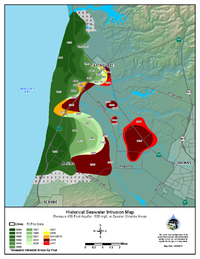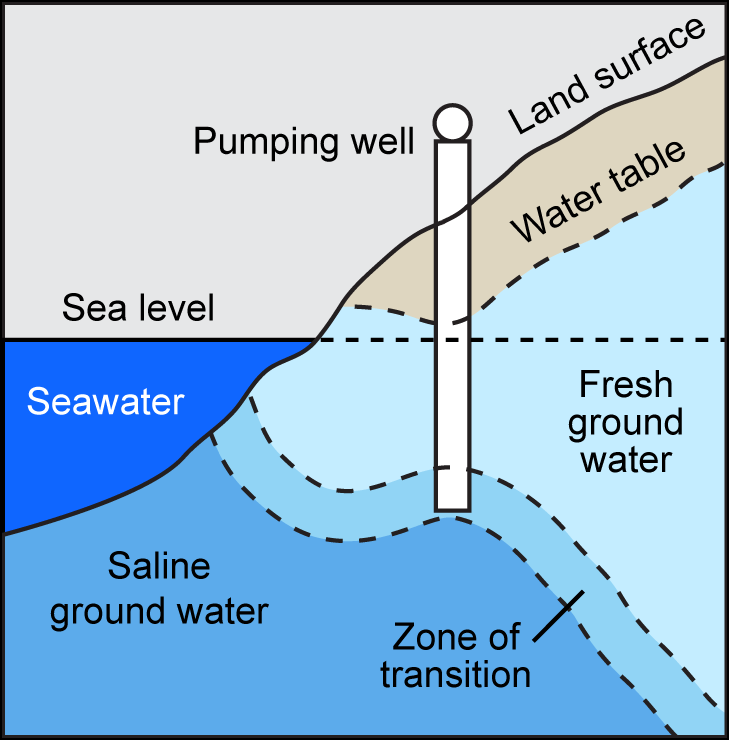Under natural conditions, it is the seaward movement of freshwater that prevents seawater from encroaching on coastal aquifers. However, when groundwater is pumped from a coastal aquifer, the lowered water levels can cause seawater to be drawn toward the freshwater zones of the aquifer.
Seawater intrusion associated with groundwater overdraft and lowering of groundwater levels has occurred in many of California’s coastal aquifers, including along the Central Coast and in Southern California. Seawater intrusion is the only undesirable result limited largely to coastal areas.
Quantifying the extent and rate of seawater intrusion is key to sustainable management and use of groundwater resources.
For more information, click here to visit the USGS webpage for seawater intrusion.
Key information
Salinas Valley seawater intrusion
 Seawater intrusion into the Salinas Valley aquifers has advanced since it was first measured in 1944. In 2014 elevated salinity levels were recorded less than 1/2 mile from the city of Salinas and was beginning to encroach beyond the limits of Castroville, CA.
Seawater intrusion into the Salinas Valley aquifers has advanced since it was first measured in 1944. In 2014 elevated salinity levels were recorded less than 1/2 mile from the city of Salinas and was beginning to encroach beyond the limits of Castroville, CA.
Maps from 2018 indicate that these elevated salinity levels may have increased. The extent of seawater intrusion has moved farther inland due to continuing overdraft conditions for municipal and agricultural uses.
For more information:
The Monterey County Water Resources Agency monitors the movement and extent of seawater intrusion by testing a series of wells located in the coastal northwestern portion of Monterey County.
Other sources of information:
Ventura County seawater intrusion
The Oxnard Plain basin, located adjacent the Pacific Ocean in southern Ventura County, California, has a long history of groundwater overdraft and saline intrusion. Major investments in infrastructure for groundwater recharge and distribution, State Water Project imports and regulatory programs to manage groundwater extraction have only been partly successful in mitigating groundwater overdraft in the Oxnard Forebay, Oxnard Plain and Pleasant Valley basins.
For more information:
-
-
- Sunshine, beaches and…saltwater intrusion? article from EDF’s Growing Returns blog
- Saline Intrusion Update, Oxnard Plain And Pleasant Valley Basins, 2016 report from United Water Conservation District
- Looking at Land Use: The Fox Canyon Groundwater Management Agency GSA games out seawater intrusion impacts against remedial actions of fallowing coastal farmland in its Oxnard Groundwater Sustainability Plan
-
Seawater Intrusion in a Coastal California Aquifer
[pdf-embedder url=”https://f0b.362.mwp.accessdomain.com/wp-content/uploads/2020/09/Ventura-County-subsidence-USGS.pdf” title=”Ventura County subsidence USGS”]Southern California seawater intrusion
Seawater intrusion due to heavy groundwater extraction was identified as a problem in Southern California by the early half of the 20th century. In the 1950’s, construction began on the first of three “barriers” in an attempt to halt saltwater intrusion. Each barrier consists of a series of injection wells that essentially form a subsurface wall of freshwater designed to keep saltwater from penetrating further into aquifers.
For more information:
-
-
- Battling Seawater Intrusion in the Central & West Coast Basins, Technical bulletin from the Water Replenishment District of Southern California
-

